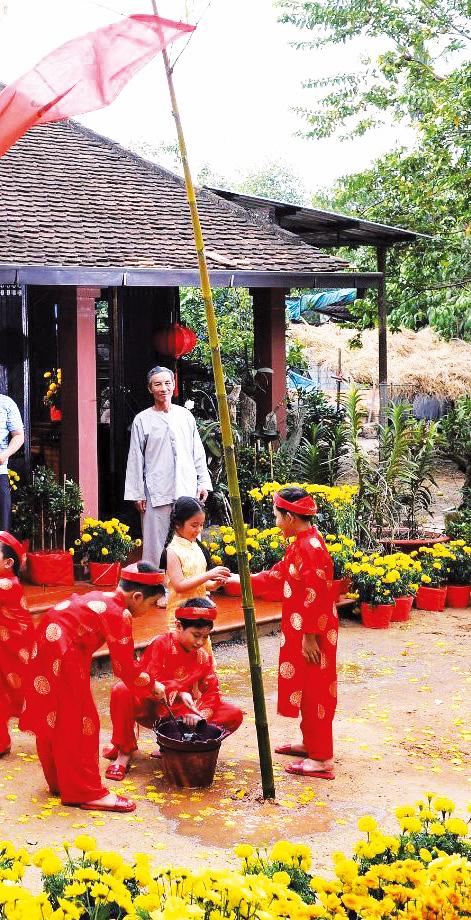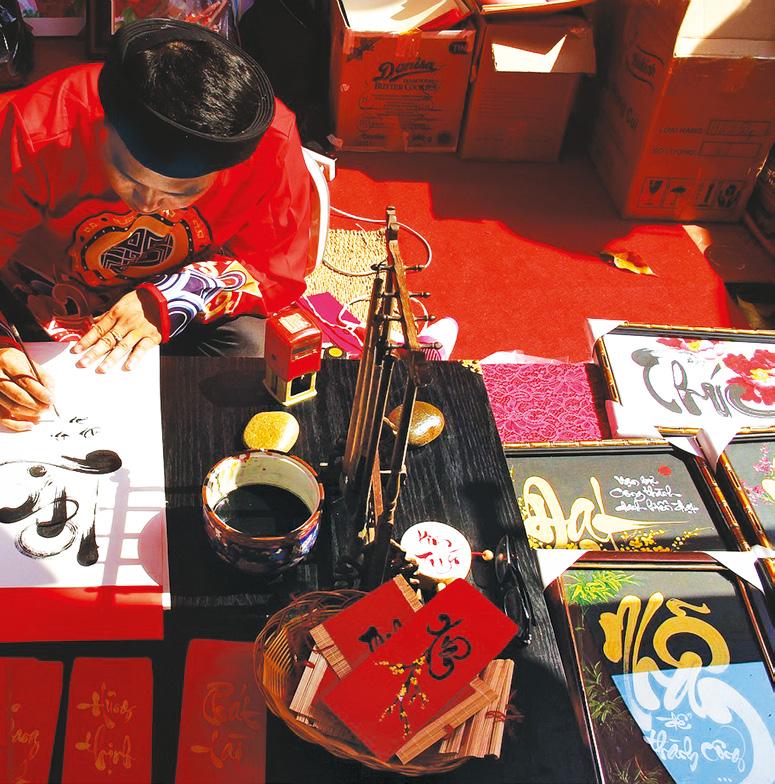
5 minute read
The Tet tradition in Vietnam
from BIDV Review 56
by BIDV Review
Thanh Xuan
Vietnamese New Year, or ‘Tet’ is the most important and longest festival in Vietnam and is a time for family reunion and best wishes.
Advertisement
Tet takes place from the first day of the first month of the lunar calendar (around late January or early February) until at least the fifth day. Many Vietnamese prepare for Tet by cooking special dishes and cleaning their house. Some traditional customs during Tet include visiting relatives’ houses on the first day of the new year, ancestral worship, sending New Year’s greetings, and giving ‘lucky money’ to children and elderly people.
Tet is also an occasion for family reunions. During Tet, Vietnamese people usually return to their families. Some return to worship at the family altar or visit the graves of their ancestors in their homeland.

Kumquat trees are popular during Tet, symbolising the fertility and fruitfulness

Banh chung, a special cake at Tet, made from sticky green beans, and pork
Tet is a time for family reunion

Like other Asian countries, Vietnamese believe that the colours of red and yellow will bring good fortune and these colours can be seen everywhere at Lunar New Year.
In the two weeks leading up to Tet, the atmosphere is bustling. Streets and markets are full of people. Everyone is busy buying food, clothes, and decorations for their houses. Each family cooks special traditional foods such as banh chung (a special cake made from sticky rice, green beans, and pork).
Vietnamese families buy peach blossom trees, kumquat trees, and orange trees to decorate their homes. These symbolise the fertility and fruitfulness that the family hopes for in the coming year. People also buy flowers to decorate their homes such as chrysanthemums or orchids.
The first day of Tet is reserved for visiting family and relatives. Children wear their new clothes and give their elders the traditional Tet greetings before receiving lucky money (li xi) from them in exchange. The second day is set aside for special guests and close friends to visit, and the third day is for teachers and business associates.
Since the Vietnamese believe that the very first visitor a family receives in the year determines their fortune for the entire year, a person of good temper, morality and success is a lucky sign for the host family and will be invited first into the house. This special activity is called xong dat, which is one of the most important rituals during Tet.

Peach blossoms signal Vietnam’s Tet
According to Vietnamese tradition, if good things come to the family on the first day of the lunar New Year, the entire following year will also be full of blessings.
Sweeping during Tet is a taboo since it symbolises sweeping away luck. It is also taboo for anyone who experienced a recent loss of a family member to visit anyone else during Tet.
Vietnamese Lunar New Year is an indispensable part of the life of all Vietnamese people. During Tet, many traditional festivals take place across the country.
The traditional greeting in Vietnam at Tet is “Chuc mung Nam Moi” (Happy New Year). People also wish each other prosperity and luck. Common wishes for Tet include:
An khang thinh vuong (Security, good health, and prosperity)
Van su nhu y (May myriad things go according to your will)
Suc khoe doi dao (Plenty of health)
Quynh Chi
Calligraphy -an ancient Tet art

Tet traditions in Vietnam have changed greatly compared to years ago, however, a number of special ancient traditions are still alive today, including the art of calligraphy.
Tet calligraphy reflects the importance of knowledge and people’s expectations for a prosperous year and happy life. People choose a word that represents their desire for the new year ahead. Older

people tend to choose words such as “Health”, “Longevity” and “Happiness” while younger ones prefer words like “Wealth”, “Love” or “Success”. Depending on the purpose and age of the recipients, the calligraphers will advise them on appropriate words.
Every year from the second day of the New Year, the Spring Calligraphy Festival is held, and hordes of people visit Van Mieu – Quoc Tu Giam (The Temple of Literature) to ask a calligrapher to scribe special words for them. Here, visitors can also see images of Tet in Vietnam from the past.
Calligraphers wear traditional long gowns and prepare brushes, ink and red paper. Red is chosen as it is the most vibrant colour and in Vietnam is perceived as the colour of life and rebirth and a symbol of life and luck. Besides traditional materials such as wood, stone, bamboo and silk, sometimes orange and gold-coloured paper is used for calligraphy.
Calligraphers will display the words, in both Vietnamese and Han script
recipients hope that through their work they will enjoy good luck.

Beside single words, people often ask for the writing of a pair of sentences which must contain parallel sentences (cau doi). Hanging vertically in the living room of every family, the parallel sentences on red papers are inscribed with wishes like happiness, prosperity and longevity. The writers of such parallel sentences have to follow a complex set of rules concerning the tone and meaning of the corresponding words.
As well as the Temple of Literature in Hanoi, a “Calligrapher Street” is also organised in many provinces and cities throughout the country, as part of the spring festivals or at temples and pagodas.
(Chinese) for people to choose. Their hands move gently and carefully to create skillful handwriting like dragons flying and phoenixes dancing on the red paper. Strokes vary from thin to thick, some vertical, and are always clear, strong and graceful. When printing the characters, calligraphers explain the meaning of each letter for receivers to ensure they fully understand.
Each word embodies the soul, knowledge, and personality of calligraphers, who are usually knowledgeable people. The











